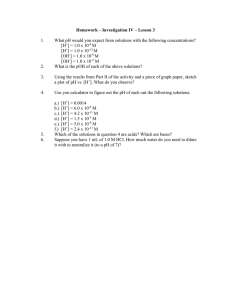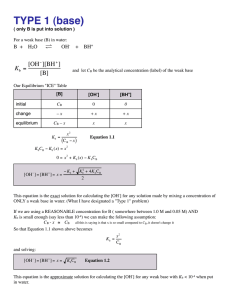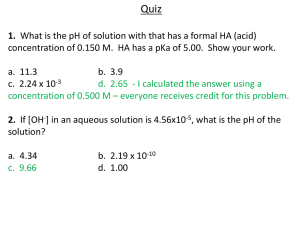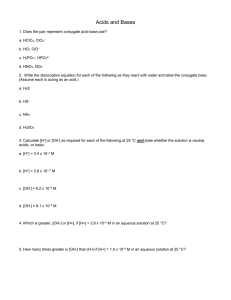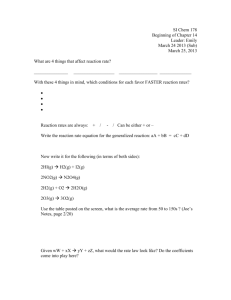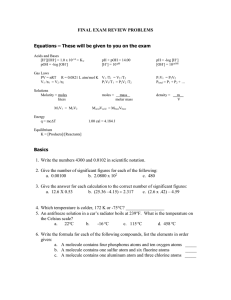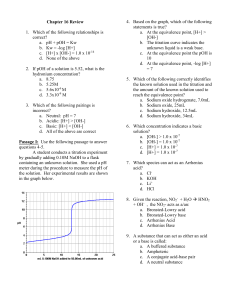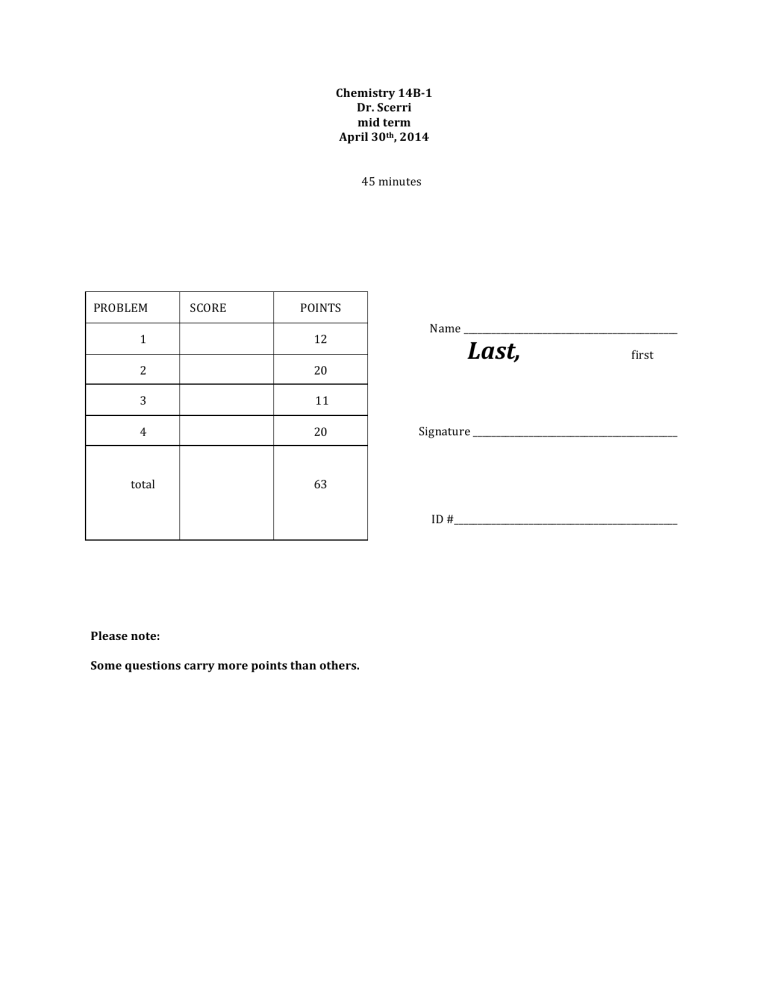
Chemistry 14B-­‐1 Dr. Scerri mid term April 30th, 2014 PROBLEM SCORE 45 minutes POINTS 1 12 2 20 3 11 4 20 total 63 Please note: Some questions carry more points than others. Name ______________________________________________ Last, first Signature ____________________________________________ ID #________________________________________________ 2 Instructions: This exam has 4 questions and a periodic table at end of exam. Verify you have the right number of pages before you begin. Write your name on each page. Raise your hand if you don't understand a question. SHOW YOUR WORK! No credit will be given for an unsubstantiated or illegible answer. Write legibly, use proper units throughout and use significant figures in all answers. If you exceed the line limit any additional material will not be read by graders Good luck! P V = n R T, R = 8.3145 J mol-­‐1 K-­‐1, = 0.0820578 L atm mol-­‐1 K-­‐1 1 L atm = 101.325 J 1 calorie = 4.184 Joules PA = XA P T ΔE = (3/2) n R T ΔE = q + w, ΔG0 = ΔH0 -­‐ TΔS0 ΔG = ΔG0 + RT ln Q ΔG0 = - RT ln K S = kB ln W ΔS = qrev / T ΔG = -­‐ T ΔS ! ΔH!"#$%&'( = ΔH!! 𝑃𝑟𝑜𝑑𝑢𝑐𝑡𝑠 − ΔH!! 𝑟𝑒𝑎𝑐𝑡𝑎𝑛𝑡𝑠 ln [A] = - kt + ln [A]0 t 1/2 = ln(2) / k 1 / [A] = kt + 1/ [A]0 t 1/2 = 1 / k [A]0 ln (k1 / k2 ) = EA / RT ( 1/ T2 - 1 / T1 ) k = A e –EA/RT ΔG = -­‐ n F E E0 cell = E0 red + E0 ox or E0 cell = (E0 more + ) -­‐ (E0 more -­‐ ) E = E0 -­‐ (RT/nF) ln Q E = E0 -­‐ (0.0592/n) ln Q at 298 K # of moles deposited = (It)/nF 2 3 1(a) An equation for work done by gas expansion is w = -­‐ P ΔV. Under what conditions is this true? Also explain how this equation can be used to obtain an equation for the heat accompanying the same process. Again explain any assumptions. (4) 1(b) The ΔG0 value for the following reaction is -­‐33.32 kJ. N2 + 3 H2 ßà 2 NH3 Calculate ΔG for a reaction mixture at 50oC that contains the following gases with the following partial pressures, 6.0 atm. N2, 3.0 atm. H2 and 0.70 atm. NH3. (4) 1(c) Discuss the spontaneity of a reaction for which ΔS is positive and ΔH is positive. (2) 1(d) Discuss the spontaneity of a reaction for which ΔS is negative and ΔH is negative. 3 (2) 4 2(a) Given the following data, P4(s) + 6 Cl2(g) ⇒ 4 PCl3(g) ΔH = -­‐ 1225.6 kJ P4(s) + 5 O2(g) ⇒ 4 P4O10(s) ΔH = -­‐ 2967.3 kJ PCl3(g) + Cl2(g) ⇒ PCl5(g) ΔH = -­‐ 84.2 kJ PCl3(g) + ½ O2(g) ⇒ Cl3PO(g) ΔH = -­‐ 285.7 kJ calculate ΔH for the reaction P4O10(s) + 6 PCl5(g) ⇒ 10 Cl3PO(g) (10) 2b. Deduce the change in entropy of a gas container with 105 particles after the volume changes to fifty times its original value. (6) 2c. Under what conditions does the following equation apply? What is the main assumption made in the derivation of this equation and how can this assumption be realized in practice? (4) 𝑤 = −𝑛𝑅𝑇[𝑙𝑛 4 𝑉𝑓 ] 𝑉𝑖 3(a) 5 Here is the mechanism for the reaction of HCl and propene CH3CHCH2 in the gas phase HCl + HCl ⇔ H2Cl2 HCl + CH3CHCH2 ⇔ CH3CHClCH3* * CH3CHClCH3 + H2Cl2 ⇔ CH3CHClCH3 + 2 HCl Obtain a rate law based on this mechanism (fast) (fast) (slow) (6) (2) Write the overall reaction 3(b) The following data were obtained at 25° C for the reaction, C2H5Br + OH- = C2H5OH + BrDetermine the rate law for the reaction from these data. [C2H5Br] [OH-] 0.150 0.200 0.150 0.400 0.450 0.200 Choose one correct answer (c) (a) Rate = k[C2H5Br]2 Rate = k[C2H5Br][OH-] (e) (3) Rate 4.8 x 10-5 4.8 x 10-5 4.32 x 10-4 (d) Rate = k[C2H5Br]2[OH-] 5 (b) Rate = k[OH-]2 Rate = k[C2H5Br]1[OH-]2 6 4(a) Consider 2 half-­‐cells one consisting of iodine and the other of the dichromate ion. Give balanced half-­‐cell equations for each half-­‐cell involving the following compounds of these metals. Assume basic conditions. (8) I2(s) ⇔ I-­‐(aq) E0 = +0.54 volts Cr2O72-­‐ (aq) ⇔ Cr3+(aq) E0 = +1.33 volts 4(b) Use the standard reduction potential data to predict the direction in which the reaction will occur and explain your reasoning. (3) 4(c) State what is being oxidized and what is being reduced in each half-­‐cell and identify the anode and cathode. (4) 4(d) Explain briefly how standard half-­‐cell reduction potentials are actually measured. _________________________________________________________________________________________________________ _________________________________________________________________________________________________________ ______________________________________________________________________________________________________(3) 4(e) Calculate the cell potential of the above iodine -­‐ dichromate cell. (2) 6 7 7
